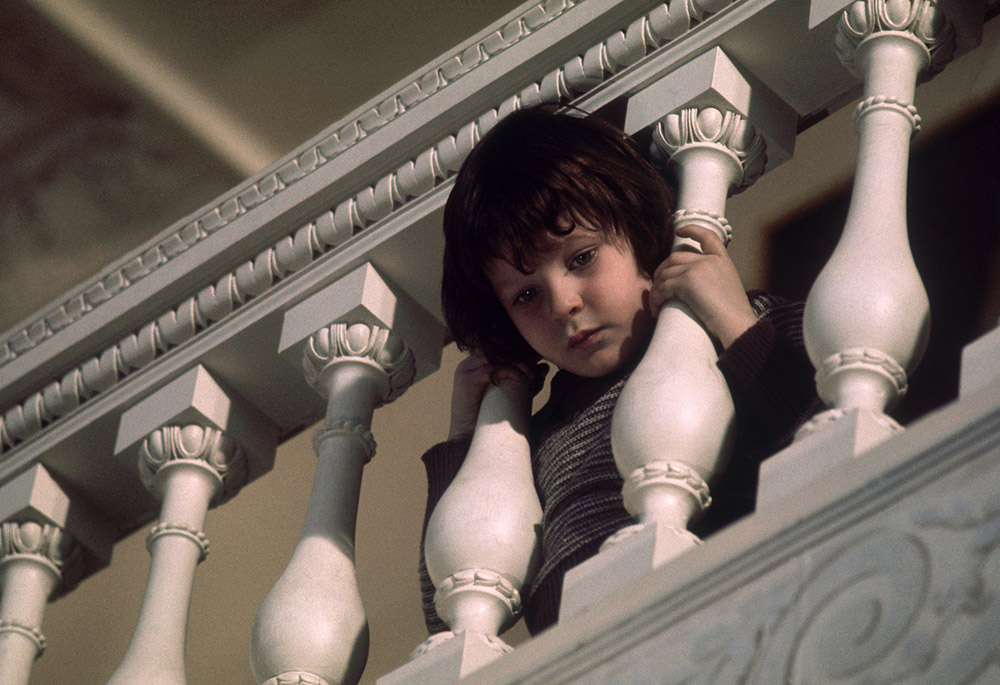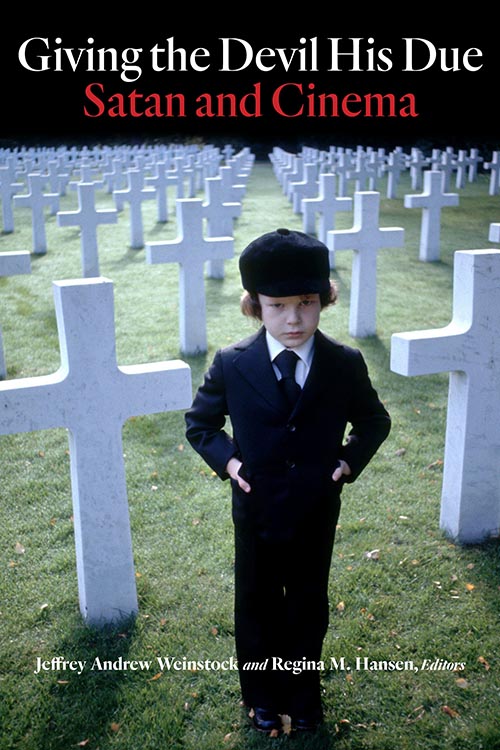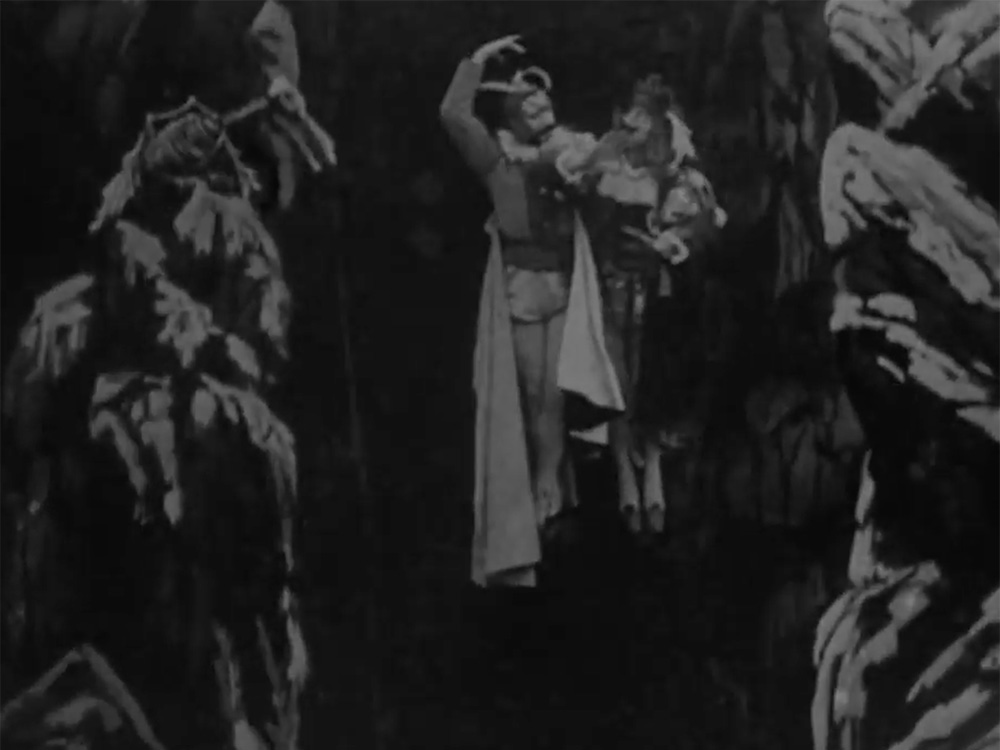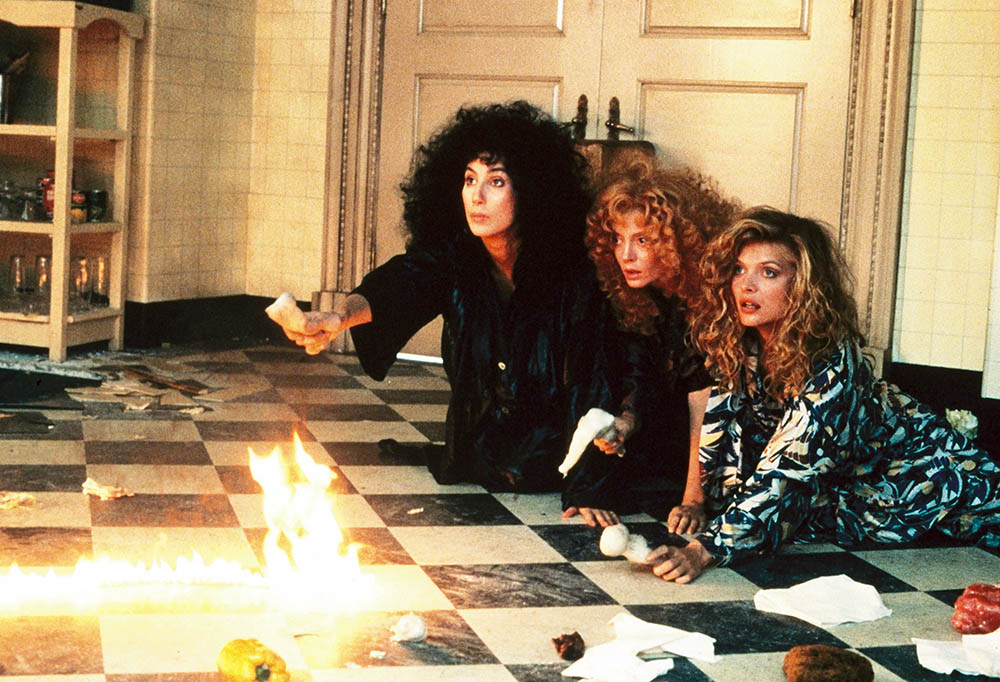
A scene from "The Omen" (1976), directed by Richard Donner (Newscom/Album/20th Century Fox)
Elliot (Brendan Fraser): Yeah. I sold my soul.
Cellmate (Gabriel Casseus): Hope you got something good for it.
Elliot: As a matter of fact, I got nothing for it.
Cellmate: Well, that's a really bad deal if you ask me.
Elliot: Well, I'm not asking you.
Cellmate: Doesn't really matter, though. Can't sell your soul anyway.
Elliot: Oh, really? Why do you say that?
Cellmate: Because it doesn't belong to you in the first place. No way, no how.
Elliot: So who does it belong to?
Cellmate: It belongs to God. That universal spirit that animates and binds all things in existence. The devil's gonna try to confuse you, that's her game. But in the end, you're gonna see clear to who and what you are, and what you're here to do. Now, you gonna make some mistakes along the way, everybody does. But if you just open up your heart, and open up your mind, you'll get it.
Elliot: Who are you?
Cellmate: Just a friend, brother. Just a really good friend.
—From "Bedazzled" (2000)

In this unique collection of essays on the cinematic and theological history of the devil in films, co-editors Jeffrey Andrew Weinstock of Central Michigan University and Regina M. Hansen of Boston University, have gathered 14 devilish essays, if you include their fine introduction, to fill "a gap in cinema scholarship," given that the evil has appeared in movies since the very beginning.
Although the first short films originated in 1896 from the French stagecraft master of tricks and illusions turned filmmaker, Georges Méliès (who is given his due in the book), Satan and cinema in the United States are as popular as ever.
To prepare to review Giving the Devil His Due: Satan and Cinema, I watched all the feature films referred to in the book that I had not already seen except two, "The Prophecy" (1995) and "The Devil and Daniel Webster" (1941). Then as I read, I kept my laptop open and when I came across a reference to an older film I had not seen in a while (now in public domain), I found it on YouTube and watched it. To refresh me on films I had seen before, I watched the trailer. Never has YouTube proved so helpful in reviewing a book.
Although most people wouldn't read a book like this straight through, I did over three days and watching the films as I read served to illustrate the book. I recommend this approach as you can understand the context of the film and reflect on or question the author's analysis and conclusions. You can "see" what they are talking about.
The book takes a historical, almost chronological approach to discussing films about the devil. They mostly fall within the fantasy-horror genre and are meant to entertain audiences rather than teach about the devil — even though some do it rather well, relying on the trope of the Faustian bargain that we find in Genesis and images that we find in other biblical texts.

A scene from Georges Méliès' 1903 film "Faust aux enfers," or "The Damnation of Faust" (NCR screenshot)
The films are most mainstream when they take a comedic approach to the devil, such as in "Oh, God! You Devil" (1984), starring George Burns as both God and the devil yet God and the devil come out as we think they are. Horror films can deal with the supernatural, but films about Satan fall within the scope of the religious, theological and spiritual.
But why do people go to see films about the devil? The editors believe that they appeal to us because "they ask us to imagine a world governed by different principles," read transgressive principles, other than what we have learned in a conservative religious culture. But we also watch them because they "affirm our worldview."
The authors mention our cultural anxieties often as motive for seeing these films because the devil often embodies them. Only one author, David Sterritt, professor of film at Maryland Institute College of Art, mentions fear as a motivating factor when he quotes Ira Levin, author of the novel Rosemary's Baby on which the 1968 film is based, from an interview in 1978: "Horror stories 'touch our fears, anxieties and guilts.' "
I tend to agree with Levin and horror director Wes Craven who told another horror film director, Scott Derrickson ("The Exorcism of Emily Rose"), in an interview where I was present, "People go to horror movies because they are already scared." They go because there is a beginning, a middle and an end, and they can leave believing that their fears, whatever their source, can be contained and even resolved.
After the more or less historical approach to Satan films, the last four chapters are thematic. One deals with "The Satanic Complications of Female Autonomy in The Witches of Eastwick and The Witch" that I found one of the more interesting chapters in the book. Though one of the films is humorous and the other very dramatic, their fleeing from the limiting conventions of their lives to the arms of the devil (or coven of witches as the Satan's henchwomen), they are never really free, in the view of independent scholar Simon Bacon.

From left: Cher, Susan Sarandon and Michelle Pfeiffer in a scene from the 1987 movie "The Witches of Eastwick" (Newscom/Album/Warner Bros.)
Satan's role in the life, passion and death of Jesus are treated in Catherine O'Brien's analytic comparison between Martin Scorsese's controversial "The Last Temptation of Christ" (1988) and Mel Gibson's also controversial (though for different reasons) "The Passion of the Christ" (2004) in "Roaming the Earth." O'Brien, the director of the Centre for Marian Studies, St. Mary's University, Twickenham, England, has written an essay that deserves its own book.
Hansen tackles the convoluted tensions between angelic and demonic wills in "The Prophecy" (1995) and "Constantine" (2005).
Finally, David Hauka, who teaches film at Capilano University and the University of British Columbia, astutely tackles the highly influential evangelical notions of the end times and second coming of Christ in "Advocating for Satan: The Parousia-Inspired Horror Genre." This chapter rightly examines how filmmakers that use Protestant storylines use and often misuse Catholic imagery and theology. These filmmakers often use the trope that a person who commits suicide goes to hell, thus showing, in my experience of watching devil movies, an irresponsible lack of research on many things Catholic, but especially that the Catholic Church no longer condemns those who commit suicide.
The best chapter in the book I think is R. Barton Palmer's "From the Eternal Sea He Rises, Creating Armies on Either Shore: The Antichristology of the Omen Franchise." Palmer, professor of literature emeritus and founder of the World Cinema Program at Clemson University, takes on the development of "high concept horror" to how Richard Donner's 1976 "The Omen" created a home-run formula for the entertainment industry that continues today. If the devil is in the details, then the profit motive in films about Satan deserves consideration.
This chapter can be read with that of Hauka's as it takes a deep dive into the many forms of the antichrist as a theme in movies about the devil, from images in the Scriptures to centrality of the antichrist in Christian culture that emerged from a small sect in England around 1830. St. Irenaeus of Lyons, soon to be declared a doctor of the church, is credited with linking the image of the beast of John's Book of Revelation with Paul's "final enemy" described in 2 Thessalonians — that has influenced portrayals of cosmic upheaval in these films.
Advertisement
The most annoying chapter, at first read, is Brigham University's Carl H. Sederholm's chapter on "The Weird Devil: Lovecraftian Horror in John Carpenter's Prince of Darkness." This 1987 film does not hold up to a contemporary viewing. It is completely boring until you realize that the devil is presented as a tower of green slime. Going beyond the visually expected was advice from H.P. Lovecraft, so okay.
Giving the Devil His Due is very Catholic in its understanding of Satan and evil, and some authors refer to the teachings of St. Augustine, St. Thomas Aquinas and the Catechism of the Catholic Church. It demonstrates how films about the devil, the great liar and trickster (somewhat like film itself, which uses illusion to create its own reality), began and continue by giving us devils that reflect what we expect and know about him (unlike the title, the text uses "them" instead of a male or female pronoun).
From so many Faustian-bargain-inspired films to those about Christ, this book is an academic yet accessible tome about cinema history and the devil. Every horror film nerd, film critic and even homilist should read it. But most of all, filmmakers of satanic films need to read it. If you are going to entertain us, get it right.
I was able to do an email interview on Oct. 22 with co-editor Weinstock. The interview has been edited for length and clarity.
Pacatte: What brought this book into being? How long has it been in development? How did you interest Fordham University Press in publishing it?
Weinstock: The impetus for the collection was the recognition of a curious gap in cinema scholarship; very little academic attention had been paid to films featuring the devil, despite their ubiquity and long history. My co-editor, Regina Hansen of Boston University, and I felt this presented an opportunity to explore an interesting aspect of popular culture.
The pace of academic publishing is slow in general; however, this collection took an unusually long time to develop. Regina and I began playing with the idea for a collection in the fall of 2012 and began actual work on it in the spring of 2015.

Jeffrey Andrew Weinstock (Wikimedia Commons/Evers1a)
Once we felt we had a viable project, we approached Fordham University Press with whom I had previously published my monograph Scare Tactics: Supernatural Fiction by American Women.
How did you find/decide on the authors and their topics?
In many cases, scholarly collections of edited collections begin with a general call for proposals. The result is often a kind of hodge-podge of chapters as the editors select from the heterogenous assortment of proposals received.
Regina and I wished to avoid that, so we began by considering films we felt should receive some attention. Once we had a list in mind, we then invited particular scholars with well-established backgrounds in cinema studies who we felt could address the films in knowledgeable and interesting ways. We were very pleased to end up with a cast of contributors including some extremely well-established scholars such as J.P. Telotte, David Sterritt, and R. Barton Palmer.
What is your perceived or hoped-for audience for the book?
The volume is a collection of non-fiction essays on different directors and films that feature the devil in a central way. We hope that it will interest not just academics, but the "educated layperson" with interests in film, religion, and popular culture.
What is your background in the area of a specifically Catholic perspective on the devil in cinema (used as a critical framework)? Why are you interested? Is it because "cinema has always been interested in God"? Please comment.
My areas of expertise include horror, film, and popular culture. It is because I am not an expert in religion that I proposed collaborating on the project with Regina, whom I have known for a long time and whose area of expertise is religious studies. (Her other publications include the books Roman Catholicism in Fantastic Film and Supernatural, Humanity and the Soul: On the Highway to Hell and Back.) For this project, our backgrounds, interests, and areas of expertise complemented each other nicely.
Where interest in the subject matter is concerned, I have always enjoyed films about the supernatural, including those involving demons and the devil. The collection has served as an occasion to explore that interest more fully and to think about what those films mean and why they appeal to viewers.
Why do you really think people like these films?
While it is always hazardous to generalize about "people" as the reasons people enjoy different films and types of films will vary from person to person, I do think at least part of the equation is the opportunity to entertain the idea of a world that goes beyond that of the physical senses.
Rachel Weisz in a scene from the 2005 movie "Constantine" (CNS/Warner Bros.)
Scholar Victoria Nelson proposes in her study, The Secret Life of Puppets, that in contemporary culture, fantasy for some has moved into a space vacated by conventional religious belief. Many religions insist on the idea of the transcendental — a plane of spirit beyond the physical. Fantasy films involving demons and the devil may feed that same desire for belief in a more capacious universe.
Movies involving the devil also often present a clarified moral framework in which there is good, there is bad, and distinguishing the difference is usually pretty easy — for the audience if not the characters in the film. That may be an attractive proposition for viewers attempting to negotiate the complexities of existence in which things are seldom black or white, but usually shades of gray.
As a film critic I found the book very interesting, if not eclectic. For example, I don't think that John Carpenter's "Prince of Darkness" holds up; I cannot imagine a modern audience sitting still for it — though I can see it in a classroom, especially the Lovecraft influence. Can you comment?
"Prince of Darkness" is such a curious film! We felt it merited inclusion for its unique representation of the devil. There really is nothing else quite like it. Our contributor, Carl Sederholm, also does an excellent job of contextualizing it in relation to late 1980s cultural shifts.
Some of the worst films on exorcism and Satan have come out in the last 15 years or so. As your book affirms, they use Catholic visuals and references but then the evangelical vision comes into play. What do you say to filmmakers who don't do their research or just use previous films for research? (This is true as two directors told me — sheepishly — when asked.)
This is a very interesting question, as I've never been approached by a filmmaker for advice!
I might respond that, where religious belief and ritual are concerned, one should walk carefully because, for many, these things are not just fantasy, but vital aspects of their life that they believe and care about deeply. Many people believe in demons and the devil in a literal way and are guided by their faith. Misrepresenting or belittling other people's faith and beliefs serves no positive function.
In addition, while this might be a bit controversial, I might also suggest that filmmakers have an ethical obligation to get the details right — or at least to have some compelling justification for playing fast and loose with the facts. Getting things wrong simply because one hasn't done one's research is just sloppy filmmaking — an accusation that filmmakers should hope to avoid, if only out of self-interest.








